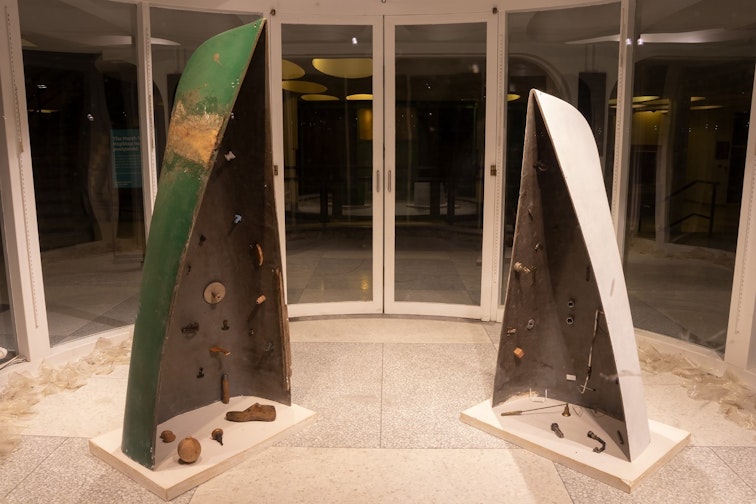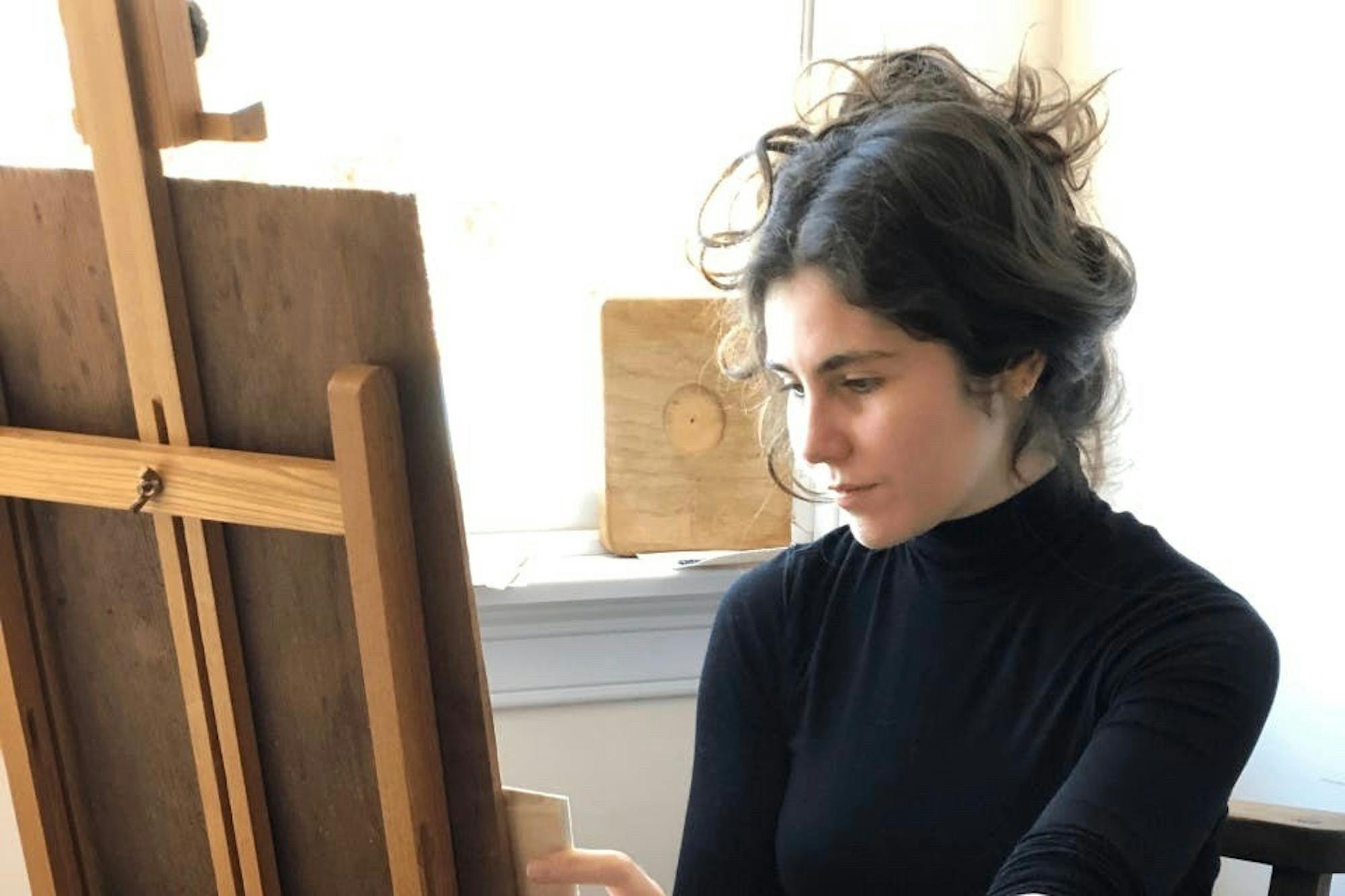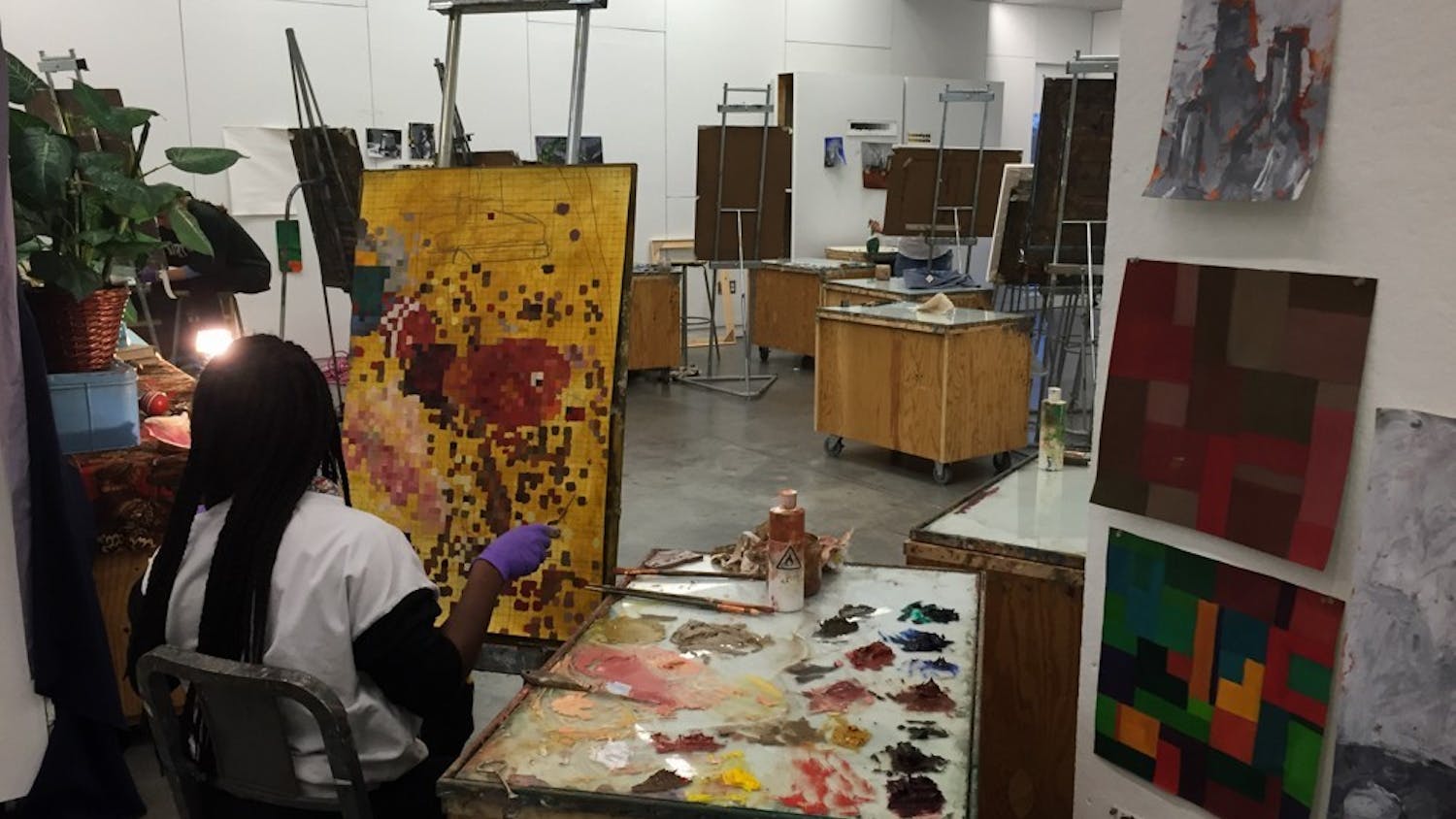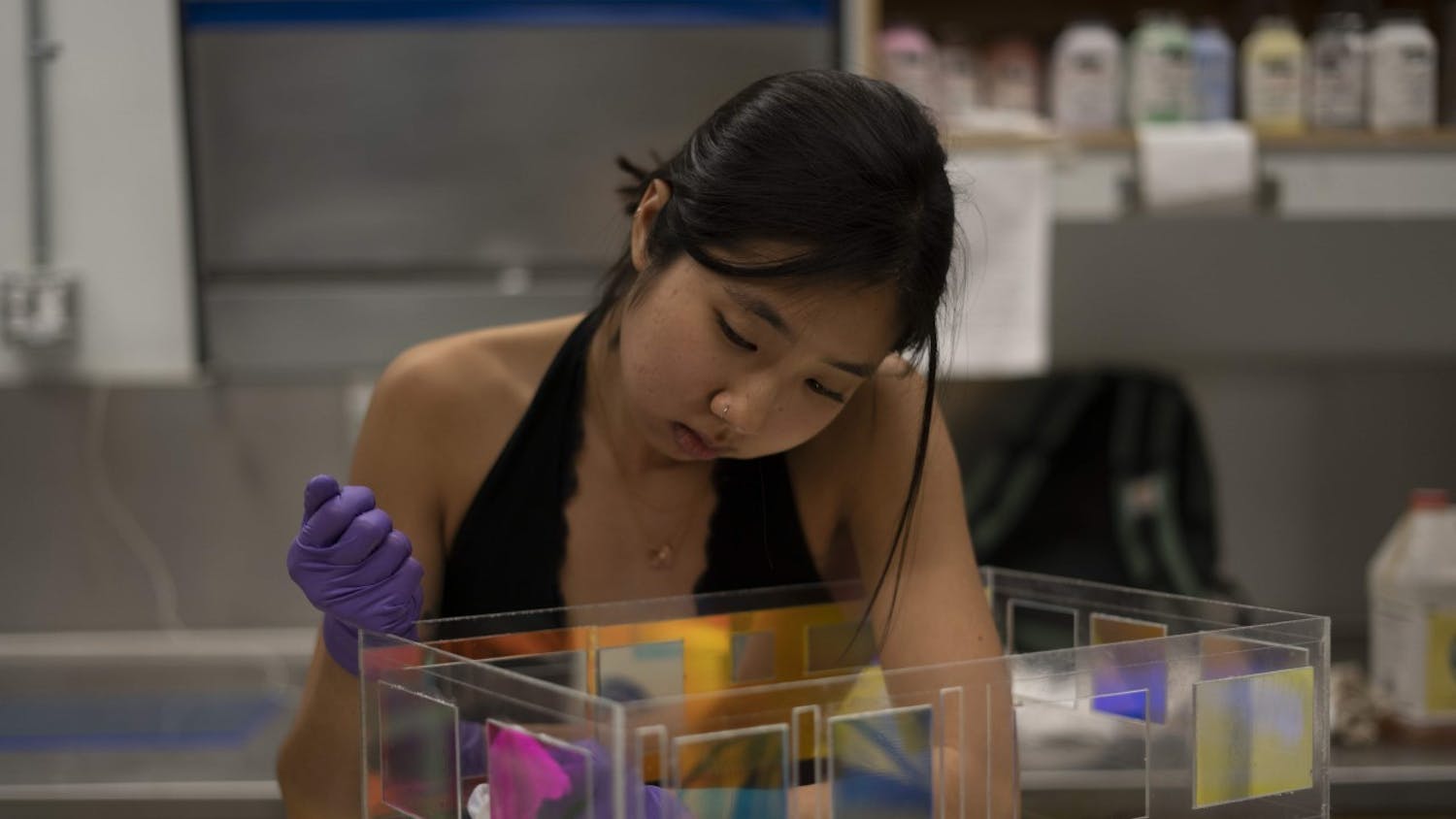While many people disregard old objects, Mary Pedicini ’19 finds a new meaning for them through her sculptures. As one of five interns selected by the studio art department, she has spent the past year working as a teaching assistant and helping faculty prepare for classes. From her life-size honors thesis project to her philosophical exhibition at the Hopkins Center for the Arts, Pedicini has developed a distinct style of creating sculptures out of found objects during her time at Dartmouth.
Pedicini’s current exhibition at Dartmouth is an installation in the Barrows Rotunda at the entrance to the Hop. Pedicini set up this exhibition, titled “Imaginary Tyrants,” prior to the start of the spring term; it is currently still on display. Her exhibition features items that she collected — the installation centers around two pieces of an old canoe with numerous smaller objects arranged within the two spaces outlined by the canoe parts.

Pedicini's exhibition "Imaginary Tyrants" is currently on display at the Hop's entrance.
Pedicini said she was inspired to create her latest installation in order to explore the idea of humans as either “thinking” or “being” creatures, an idea she developed after reading a book about growing up this past winter. This book featured imagery about children as graceful, unknowing creatures and adults as awkward, wise creatures, which led Pedicini to think about the idea of humans losing confidence and gaining wisdom as they age.
“A person who is ‘being’ sort of rushes out into the world and is confident and direct,” Pedicini said. “On the other hand, a person who is ‘thinking’ is awkward and fumbling but gets to a deeper understanding of the world. Can you separate ‘thinking’ and ‘being,’ and if so, which is better?”
When creating this installation, Pedicini assessed if and how she could separate the two concepts of being and thinking. She said she used this idea as an intuitive game to guide her process.
“While working on this piece, I would go over to a pile of objects in my studio and find one that seemed particularly interesting,” Pedicini said. “I would pick it up and try to imagine what it was like to be that object. Then I would try to tell if that object felt more like ‘being’ or more like ‘thinking’ and then I would put it into one of the two camps that it belonged to.”
Although she is not on campus, Pedicini hopes that the installation can provide comfort to students who are living at Dartmouth during the COVID-19 pandemic. With campus nearly empty this term, her piece in the rotunda is one of the few displays of student work that is visible from the exterior of a building.

With campus nearly empty, Pedicini's piece is one of the few displays of student work visible from outside.
While Pedicini’s recent work, including her exhibition at the Hop, is abstract and draws on her interpretation of objects, she originally started out making much more representational art during her time at Dartmouth.
“Until about sophomore year, I was working pretty representationally, like doing portraits of people,” Pedicini said. “Then I took a printmaking class during sophomore year, and I started making abstract prints. I think that was the start of where I am now, which is more non-representational, and I’ve also gone over to sculpture.”
Pedicini’s inspiration for her pieces arises from her research and engagement with a variety of academic fields. When Pedicini came to Dartmouth, she already knew that she wanted to major in studio art, as she had a prior interest in the field. However, she also looked forward to studying other subjects and took classes in anthropology, computer science and biology. Pedicini’s inquisitive and interdisciplinary nature guides her in confronting ideas that fascinate her through art.
Studio art professor Gerald Auten, who was Pedicini’s senior seminar instructor, said that she has a genuine intellectual curiosity about materials and their meanings in art.
“She brings this very original approach to everything she does — she’s very open-minded, and you can see it in her work,” Auten said. “She’ll take risks and she’ll make them work out.”
Auten noted that Pedicini’s senior honors thesis, titled “Method of Loci,” exemplifies her ability to take risks. Pedicini said that her thesis was a large dome-shaped installation inspired by the method of loci, a strategy developed in ancient Rome and Greece that involves the visualization of familiar spaces to enhance memory recall.

Pedicini described her honors thesis, "Methods of Loci," as a "physical manifestation" of her mind.
“The idea behind my thesis is that it is a physical manifestation of my mind,” Pedicini said. “It’s a space you can enter and the objects on the walls are memories deposited as physical objects. They each have significance to me, but for the viewers, they’re anchors to the memories that can be perceived in different ways.”
Auten also noted that Pedicini’s strengths as a teaching assistant for his senior seminar course stem from her work with assembling objects together into new sculptures.
“She’s able to address things at different scales, whether it’s sculpture, drawing, painting, photography,” Auten said. “She’s well-rounded in terms of her practice, and she brings that to the students she works with.”
Studio art professor Christina Seely, who teaches the course SART 17.22, “On Earth: Art in the Anthropocene,” for which Pedicini is a teaching assistant, noted that Pedicini’s thorough research for her pieces has helped her develop her identity as an artist.
“I think she’s been working through all this research, collecting objects and thinking about how to build experiential spaces to translate her ideas,” Seely said. “A lot of it is about how we are and who we are in the world, how we think and function, which I saw in her honors thesis. She’s at the beginnings of the evolution [as an artist], so it’s fascinating and exciting to see her foundation forming.”
Seely also said she appreciates that Pedicini has insight into being a studio art major at Dartmouth, which brings another perspective to the class.
“Having just come out of the program, she has insight into so many things that I don’t,” Seely said. “She can bring her trajectory as an artist in the program and in the school to the class, which are things that students gain a great deal from.”
Students have also felt the influence Pedicini brings through her teaching assistant roles. Leah Ryu ’22, who had Pedicini as a TA in her first studio art course, SART 20, “Drawing II,” last fall, said that Pedicini helped her overcome the challenge of moving into non-representational art and also gave her advice about the studio art major.
“I was making very detailed and representational graphite portraits, and I would think, ‘Maybe this isn’t the right way to do art,’” Ryu said. “I don’t think that’s the approach she takes at all. She told me that representational art has value and completely abstract art has value — they’re not black and white things.”
While Pedicini can’t work with students in-person, she said she’s found that teaching them through remote learning has still been a fulfilling experience. She has also used quarantine as a time to work on her own projects.
“I’m still creating art here in my apartment,” Pedicini said. “My intention is to become a practicing artist, so I hope I’ll always be making art. I had a really big studio on campus that I shared with the other four interns, and there are a few pieces that I started. I don’t know if I’ll get to finish them, but in the meantime, I’ve been working on new projects.”
When asked about her future plans, Pedicini said that she is planning on going to graduate school at the Royal College in London to study sculpture, and she hopes to become a practicing artist afterward. With the uncertainty due to the pandemic, she is trying to figure things out.
“People always say that uncertainty, tumult and to some extent isolation are a good thing for an artist,” Pedicini said. “I think to some degree that’s true, but I also believe it’s important to maintain community. For me, having positive input from others helps me stay motivated and excited to create.”




